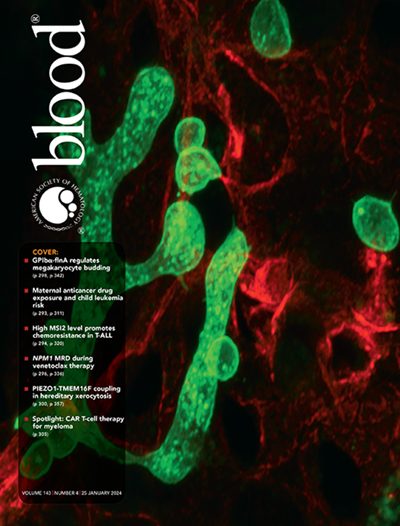Factor IXa and Factor X Influence Factor VIIIa Stability and Inactivation Mechanisms In Vitro and In Vivo.
IF 21
1区 医学
Q1 HEMATOLOGY
引用次数: 0
Abstract
Deficiency of (f)actor VIII causes hemophilia A and excess FVIII function increases venous thromboembolic risk. The phenotypic consequences of aberrant FVIII function underscore the importance of understanding mechanisms that downregulate (a)ctivated FVIII to inform disease pathology and therapeutic drug design. Spontaneous A2-domain dissociation and activated protein C (APC) proteolysis are established mechanisms of FVIIIa inactivation. However, we know very little about how FVIIIa binding interactions with FIXa and FX impact FVIIIa inactivation in vivo. Here we investigate this using recombinant FVIIIa variants to probe A2-domain dissociation (FVIIIa-D519V,E665V) and APC cleavage (FVIIIa-R336Q,R562Q) or both (FVIIIa-R336Q,R562Q/D519V,E665V) in biochemical assays and in HA mouse injury models. We found that FIXa binding to FVIIIa stabilized the A2 domain and increased the contribution of APC to FVIIIa inactivation. Additional studies using individual APC cleavage site variants (FVIIIa-R336Q and FVIIIa-R562Q) demonstrated that FIXa and FX can protect FVIIIa from APC cleavage at Arg562 and Arg336, respectively, in a manner that is incomplete in vivo. Data also demonstrate that APC inactivation of FVIIIa exceeds FVIII suggesting differential APC recognition of FVIIIa relative to FVIII. Hemostatic studies of FVIII variants with altered inactivation demonstrated that both A2-domain dissociation and APC cleavage contribute to in vivo FVIIIa regulation. Specifically, stabilizing the A2-domain, inhibiting APC cleavage, or both improved potency 2.4, 4.8, and >10-fold, respectively, over wild type FVIII in a mouse hemostatic assay. Data support that both mechanisms of FVIIIa inactivation and FIXa interactions could be leveraged to enhance FVIII function for therapeutic benefit.因子IXa和因子X影响因子viia的稳定性和体外和体内失活机制。
FVIII缺乏会导致血友病A, FVIII功能过剩会增加静脉血栓栓塞的风险。异常FVIII功能的表型后果强调了理解下调(a)激活FVIII的机制对疾病病理学和治疗药物设计的重要性。自发a2结构域解离和活化蛋白C (activated protein C, APC)蛋白水解是fviia失活的机制。然而,我们对fviia与FIXa和FX的结合相互作用如何影响体内fviia失活知之甚少。在此,我们利用重组fviia变体在生化实验和HA小鼠损伤模型中检测a2结构域分离(fviia -D519V,E665V)和APC切割(fviia - r336q,R562Q)或两者(fviia - r336q,R562Q/D519V,E665V)。我们发现FIXa与FVIIIa结合稳定了A2结构域,并增加了APC对FVIIIa失活的贡献。对单个APC切割位点变体(fviia - r336q和fviia - r562q)的进一步研究表明,FIXa和FX可以分别保护fviia免受APC在Arg562和Arg336位点的切割,但在体内的保护方式是不完整的。数据还表明,APC失活的fviia超过了FVIII,这表明APC对fviia的识别与FVIII不同。对失活改变的FVIII变异的止血研究表明,a2结构域解离和APC切割都有助于体内FVIII的调节。具体来说,在小鼠止血实验中,稳定a2结构域,抑制APC切割,或两者都提高了2.4倍,4.8倍和>的效力,分别是野生型FVIII的10倍。数据支持FVIII失活和FIXa相互作用的两种机制都可以用来增强FVIII功能以获得治疗效果。
本文章由计算机程序翻译,如有差异,请以英文原文为准。
求助全文
约1分钟内获得全文
求助全文
来源期刊

Blood
医学-血液学
CiteScore
23.60
自引率
3.90%
发文量
955
审稿时长
1 months
期刊介绍:
Blood, the official journal of the American Society of Hematology, published online and in print, provides an international forum for the publication of original articles describing basic laboratory, translational, and clinical investigations in hematology. Primary research articles will be published under the following scientific categories: Clinical Trials and Observations; Gene Therapy; Hematopoiesis and Stem Cells; Immunobiology and Immunotherapy scope; Myeloid Neoplasia; Lymphoid Neoplasia; Phagocytes, Granulocytes and Myelopoiesis; Platelets and Thrombopoiesis; Red Cells, Iron and Erythropoiesis; Thrombosis and Hemostasis; Transfusion Medicine; Transplantation; and Vascular Biology. Papers can be listed under more than one category as appropriate.
 求助内容:
求助内容: 应助结果提醒方式:
应助结果提醒方式:


